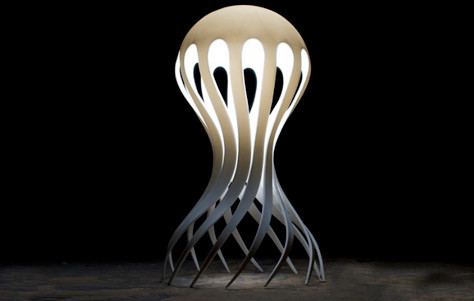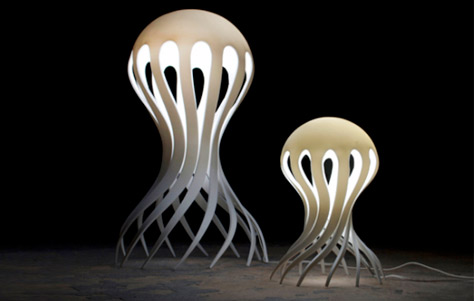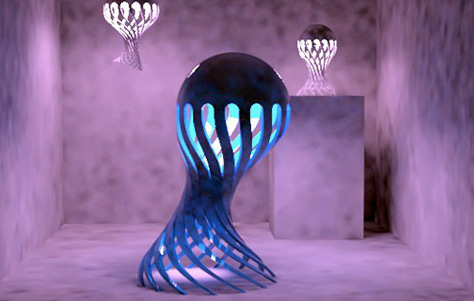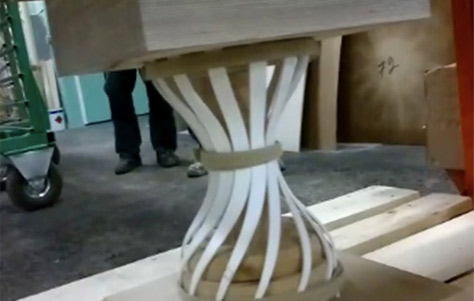
Who knew that a behind-the-scenes look at design could reveal a process as multifarious and complex as that of making a major film? And a Tim Burton film at that. The comparison holds in regard to Markus Johansson's Cirrata Lamp, especially when one sees the dozen or so miniaturized prototypes that culminated in this over-sized lightpiece that resembles a gigantic octopus.
The large lamp’s name refers to a suborder of octopi characterized by an internal skeleton and a set of two fins—unusual qualities in an octopus and ones which actually make it more vulnerable to predators. Perhaps Johannson chose the name for this reason, because Cirrata’s increased vulnerability prompts it to favor deep, dark spaces.
In such depths the creature can avoid predation, and one imagines Johannson’s imaginative vision of Cirrata profited from this biological fact. It seems likely as well, that the designer chose the hard—and heretofore less malleable—material of Corian for similar reasons, not the least of which is the intriguing way in which it absorbs and reflects light.
Using a high-heat forming process in which he molded Corian around wooden boxes, Johannson was able to stretch the material out into the luminously-long and many-appendaged parabola of Cirrata: “a body with many arms which sweeps along and lights up the depths.”
skip to main |
skip to sidebar
Home Designs Pictures, Interior and Exterior Designs, Garden, Bedroom, Room, Furniture and More
Popular Posts
-
Nowadays, the function of the garage is not only to the transportation safety. But also, to increase the performance of the home design . ...
-
Neutral Sophistication A neutral living room was given a striking edge with sophisticated hues of gold and brown. The vaulted ceilings are t...
Archive
-
▼
2011
(514)
-
▼
June
(59)
- ?qx3dwood+textureandumx3d1andhlx3d
- Bright Idea
- PETRIFIED WOOD TABLE TOP
- PETRIFIED WOOD TABLE TOP
- Closet Design For Children
- Library Of Textures (Part 1)
- Polia
- 12 Generous Wood Accents Interior Idea
- Shape Leaves an Amazing Light by Ross Lovegrove
- So Original Table Texture
- Texture Used For The Body Of
- James DeWulf
- Texture For The Floor
- Creating Wood Texture In
- Wood Texture In Beiz Graphic
- Pergola's and Patios
- Dining Styles
- Wood Texture (view 'seamless
- Mixology
- New And Polished Wood Texture
- Spotted A Good Metaphor Or
- Cozy House Design in Italy
- Blackboard
- Bath Ideas
- Modern Single Bedroom From Hulsta
- New Modern Bedroom Furniture Inspiration in Home D...
- A Beautiful And Luxurious Golf And Spa Resort
- A train for breakfast
- Using a television as a room divider
- Knock Off Wood Patio Table
- Dental Clinic Ideas at Home
- Knock Off Wood Patio Table
- Luxury Home Furniture Is A Piece Of Heaven
- Open and Airy Rooms
- Wood Slat Long Bench,
- Outdoor Wooden Table Great
- Wood As It Is Look Good In So
- Black and Bold
- My Table As Well As Where
- Wood Putty Conceals Everything
- Markus Johansson’s Cirrata Lamp
- To The Outdoor Table Of My
- Outdoor Harvest Table!
- Springing into Summer
- Square Coffee Table In Glass
- Wall to Chair
- A Coffee Table Needs To Be In
- How to Use Dark Furniture to Add Drama to your Decor
- Salvaged Wood Coffee Table
- Color Psychology
- Blue Ridge Parkway/Natures Grand Designs
- The Raft Table by Andre Joyau
- The Coffee Table That Was Made
- Coffee Table In Solid Wood
- Coffee Tables
- Coffee Table From Recycled
- Au Contraire
- A Very Interesting Table:
- One room, two looks, Design By Samantha Pynn
-
▼
June
(59)
Copyright © 2011 Excellent Home Designs | Powered by Blogger
 5:00 AM
5:00 AM
 Admin
Admin
 Posted in:
Posted in: 








